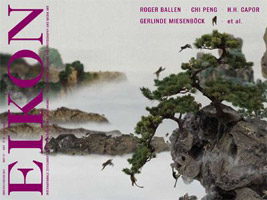|
Rosemarie Burgstaller, Crossover III: Photography - Media Art; alien productions & Machfeld Cross Talk Review on the exhibition in the Fotogalerie Wien, December 19, 2006 - January 29, 2007 |
|
Before the aforementioned background of the heterogeneous layerings of artistic practices as well as complex interactions of the most various academic disciplines and the linked recoding of traditional social notions, the approach to structuring current interdisciplinary art positions in differentiating genre components has an inherently experimental character. It is a common discourse in photography, to thematize its media translations and art immanent transgressions in the sense of expansions of (classical) genre concepts. With a hypothetic contrast to the current media art, photography can also find itself forced into action. The shared exhibition project of the two artist collectives alien productions (Martin Breindl, Norbert Math, Andrea Sodomka) and Machfeld (Sabine Maier & Michael Mastrototaro) leads into the world of computer-controlled devices, digitally generated visual modules, and digitally altered sound packets that invite us to imagine from the world of media art also photography as history. In three rooms at Fotogalerie Wien, the three installations are assigned to three fields of perception: image, text, and sound. Central in the exhibition, placed in the large exhibition space, is the work Mirrored. The projected interaction between taped journeys through space outside the gallery and the superimposed, virtual interior (of Fotogalerie Wien) discloses itself in a sense through the mirror construction set up in the midst of the actual room. If you place your nose on the right place on the mirror, this allows for a three dimensional stereoscopic perception of the projection. In the small exhibition space, in contrast, early generation dot matrix printers rattle along before a line of computers. It seems as if they might be talking to one another, but in fact they react to electronic signals of recorded small talk fed into the network. Playfully alienated, these printers no longer print text, but "speak" it in the form of a performance. In the cinema we hear Horse and Hound by Machfeld, sequences from a Western as a radio play of sounds between other soundscapes that largely emerged under the label Alien Productions. All three projects function in the collaboration of the new digital media with the older analog media, or quotes from them, as the stereoscopic apparatus exemplarily presents in Mirrored. Its presence describes the entire space as a simulation of the principle of a camera. The task is to locate photographic visual production equally as a reminiscence of the historical as well as optional of its continuation. For today as entire visual archives can be stored in pocket format, the symbolic significance of the older media increases. As they successively disappear from everyday culture, they take on a new radiance. The originally so fascinating, but also trivial notion of photography as a copy of reality emerges in the works most clearly when what is omitted becomes visual or quasi a negative moves to the foreground, as in the five Western chapters by Machfeld. The great model for this work is the first radio play Weekend (1930) by Walter Ruttmann, who termed it a "photographic radio play" |2| - it was produced by editing a film soundtrack. Horse and Hound focuses on the sounds of a film - the dull clacking of boots on the dusty wood floor, the low snap of the revolver, the horses galloping off in the distance. Neither can the dialogues of the actors be heard, nor are the images visible on the screen. Yet, when we enter this soundscape, we easily can visualize a story. It is also the imaginative that accompanies the old media and the mechanically produced images of the real, and perhaps especially impresses us. With an eye on the permanently growing capacities for storing and reloading images, this exhibition sets course for deceleration, and pleasantly suggests a restful look through the objective of a camera. |
|
1 |
"An interview wich Jean-Luc Monterosso by Heinz-Norbea Jocks, The end of photography," Kunstforum International, 172 (September/October 2004), p. 180. |
|
Translation: Brian Currid and Wilhelm Werthern | theory index | |
 As can be seen everywhere, photography's possibilities have multiplied quite a bit in the age of electronic and digital media. In the digital landscape of the present, photography moves in equally multi-dimensional as well as discursive alliances with computer technologies. It has long established a visual world of its own between reality and virtuality. Young contemporary photographers operate quite polyvalently, for example, as the director of Maison Européene de la Photographie in Paris Jean-Luc Monterosso says, "The photographer makes uses of all the means available - video, digital art - and integrates approaches from the cinema and the sculptural arts."
As can be seen everywhere, photography's possibilities have multiplied quite a bit in the age of electronic and digital media. In the digital landscape of the present, photography moves in equally multi-dimensional as well as discursive alliances with computer technologies. It has long established a visual world of its own between reality and virtuality. Young contemporary photographers operate quite polyvalently, for example, as the director of Maison Européene de la Photographie in Paris Jean-Luc Monterosso says, "The photographer makes uses of all the means available - video, digital art - and integrates approaches from the cinema and the sculptural arts."